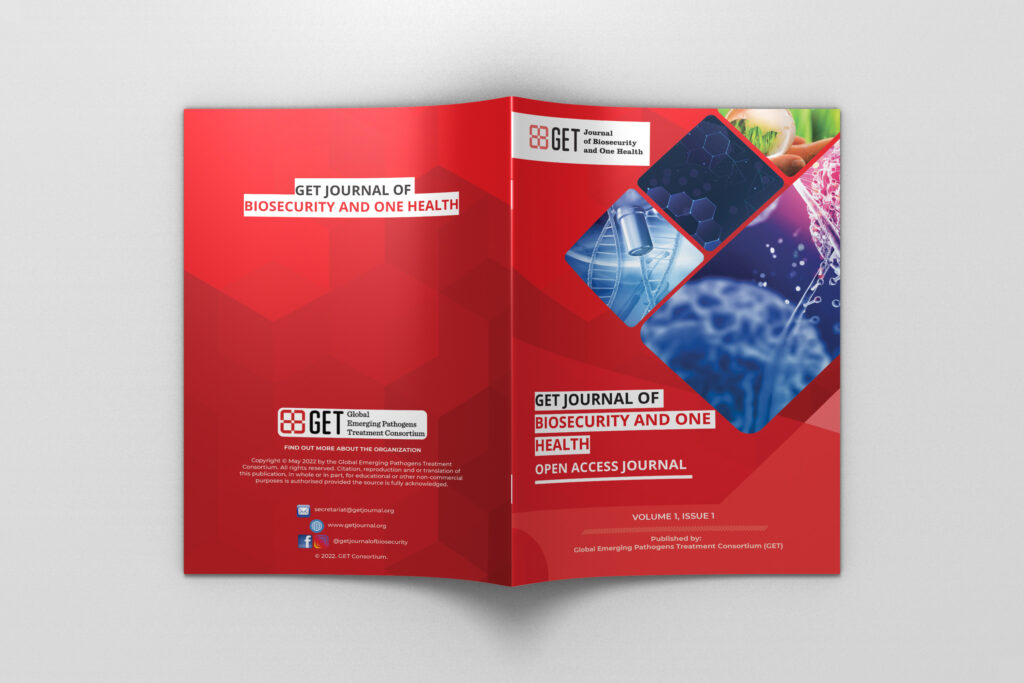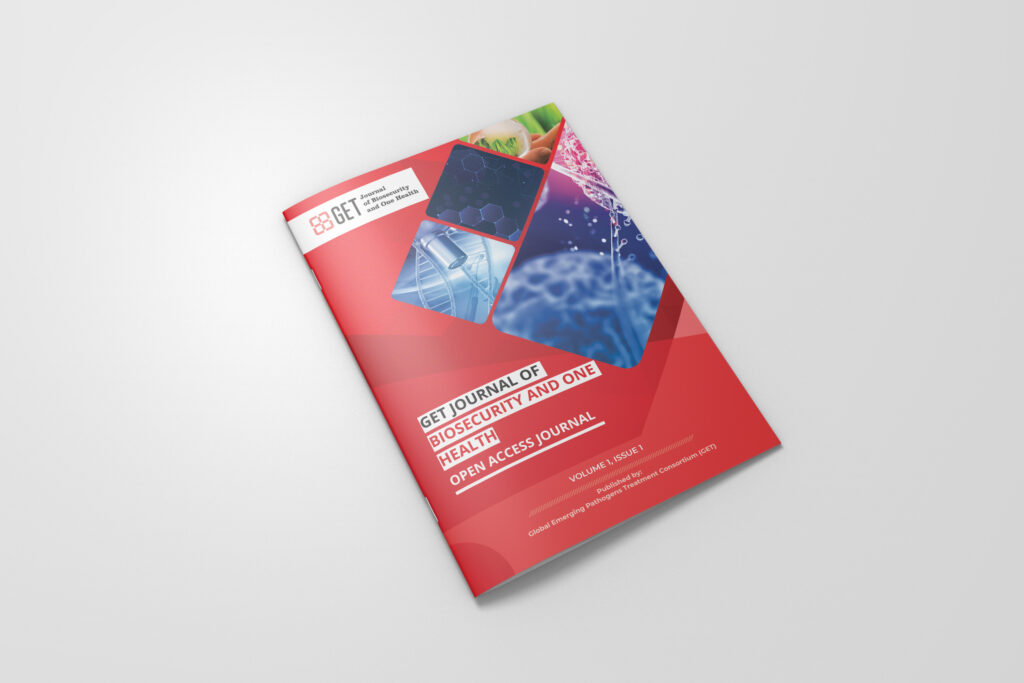GET Journal of Biosecurity and One Health
Volume 2 Issue 2
Editorial Message from the Editor-in-Chief
About GET Journal
Aim and Scope
Research Topics
The Editorial Board
Prevalence and Antibiotic Susceptibility Pattern of Staphylococcus
aureus from Urine of Patients Attending Ajikobi Hospital, Ilorin, North
Central, Nigeria.
Identification of the Requirements and Expectations of Interested
Parties in a Biobank in Sub-Saharan Africa
The Prevalence and Correlates of Sexually Transmitted Infections
(STIs) among Heterosexual HIV-1 Sero-Discordant Couples Enrolled
into HIV Prevention Clinical Trial in Western Kenya
Comparative Analysis of SARS-Cov-2 Detection Using Viral Swab in
Viral Transport Medium Against Cotton Swab in 0.9% Normal Saline
Authors: Omotosho AO1,2* and Bale MI1,3
1Department of Microbiology, Faculty of Pure and applied Sciences,
Kwara State University, Malete, P.M.B 1530, Ilorin, Kwara State.
2Department of Environmental Risk Management, School of Social and
Environmental Sustainability, University of Glasgow, DG1 4ZL, Dumfries,
Glasgow.
3Department of Microbiology and Parasitology, College of Medicine and
Health Sciences, University of Rwanda.
GET Journal of Biosecurity and One Health, Volume 2, Issue 2
Article Keywords: Antibiotic Resistance; Bacteriuria; Erythromycin; Staphylococcus aureus; MRSA; Urinary Tract Infections; Vancomycin
Antibiotic resistance is becoming the next public health emergency as opportunistic pathogens such as Staphylococcus aureus are gaining resistance to frontline antibiotics. This study aimed to determine the
prevalence and multidrug-resistant Staphylococcus aureus in urine samples of patients attending Ajikobi Cottage Hospital in Ilorin, Kwara State. A total of 170 urine samples from male and female patients of 10-70 years age groups were aseptically collected and cultured on mannitol salt agar for isolation. Biochemical tests were carried out for identification, and antbiotic susceptibility patterns of the isolates were determined using Kirby-Bauer disc diffusion technique. A total of 46 (27%) S. aureus were obtained, 40 (36%) from females and 6 (10%) from males. The highest occurrence was recorded between the ages of 21-30 and 31-40 years, with 35% and 23%, with females in these groups accounting for 55% and 22%, respectively.
This accounts for a high-rate of bacterial infection amongst sexually active women of child bearing age groups. This was followed by 19% and 17% for age groups 10-20 and 41-50, respectively. The lowest incidence from this research was recorded in age groups above 50 years, with 0%. Antibiotics sensitivity profiles of the 46 isolates of S. aureus tested showed that 71% were resistant to ampicillin, followed by 50% resistance to erythromycin, 43% to amoxicillin, followed by 26%, 19%, 13% and 8.6% resistance tocefoxitin, gentamicin, ciprofloxacin and vancomycin respectively. A total of 5 (10.8%) multidrug-resistant S.aureus was recorded from this study. Resistance to vancomycin from this study is of public health concern that requires due attention, as vancomycin is a last-resort antibiotic used to treat serious infections
Authors: Diané KM,2*, Money M1,2 Bouagnon JJR1,2, Cissé S1,2, Aka KAE1,2,
Kintossou KA1,2, Coulibaly L1,2, N’Guessan F1,2, Setchi LO3, and Dosso
M4
1Biological Resource Center of IPCI
2Regional Biobank of ECOWAS countries
3Quality, Health and Safety Department of IPCI
4Direction of Institut Pasteur of Côte d’Ivoire
*Corresponding Author: Diané Kouao Maxime: 22 bp 1271 Abidjan 22
GET Journal of Biosecurity and One Health, Volume 2, Issue 2.
Article Keywords: Stakeholders; Biobank; Sub-Saharan Africa; Knowledge; Needs and Expectation
Biobanks are important infrastructures facilitating biomedical research. It is recognized that improving the health of individuals and populations increasingly requires the use of large-scale collections of human biological samples and associated data. In this regard, biobanks are a valuable resource to facilitate effective research. The objective of this study was to identify the current and future needs and requirements
of our stakeholders, so that measures to satisfy them could be put in place. An exploratory, quantitative and qualitative study was carried out by means of an anonymous survey, on the expectations and requirements of the stakeholders of biobank. This descriptive cross-sectional study which took place over 3 weeks in 2021. Fifty (50) participants working in Abidjan and in the interior of the country agreed to
answer the anonymous survey. Among them, 32 (64.0%) were men. The professions of research biologists represented 19 (38.0%) physician-pharmacist practitioners 11 (22.0%). The overall expectations of stakeholders in relation to operational processes were: compliance with regulations, standards and best practices 42 (84.0%); feedback on uses 40(80.0%); staff safety 40(80.0%); information on the possible use
of biological resources 38(76.0%). The administrative authorities who took part in the survey unanimously
identified practically all the expectations relating to biobank management processes as important. The following essential expectations were identified: acquiring the necessary skills, internal communication
concerning quality and operations, performance/efficiency of support activities, satisfaction of interested parties, 100% staff safety. For the development of biobanks for research purposes, political decision-
makers, regulators and researchers should take into account the opinions of all social sectors, in particular the general public
Authors: Kipyego J*1,2, Oketch D 1, Kaguiri E 1, Komen A1, Kutwa G1,
Sawe J1, Ballidawa J1, 3, Ayuo P1, 4, Were E1, 5
1Partners in Prevention, Moi University School of Medicine, Eldoret Kenya
2Moi University Clinical Research Centre (MUCRC), Eldoret Kenya.
3Department of Behavioral Sciences, Moi University School of Medicine,
Eldoret Kenya
4Department of Medicine, Moi University School of Medicine, Eldoret Kenya
5Department of Reproductive Health, Moi University School of Medicine,
Eldoret Kenya
Corresponding Author: Kipyego Jairus
GET Journal of Biosecurity and One Health, Volume 2, Issue 2.
Article Keywords: STIs; HIV; Clinical trial; Discordant Couple
Sexually transmitted infections (STIs) are a major public health concern. Annually, over 300 million
infections are reported worldwide, with 75-85% occurring in developing countries, with an estimated one
million cases occurring daily. HIV-discordant couples remain at increased risk of transmission of HIV and
STIs. Improved patient education is crucial in reducing the transmission of STIs, and to achieve this optimally, new strategies need to be developed. This study sought to determine the prevalence and risk
factors associated with STIs in a cohort of heterosexual HIV-1 discordant couples in Western Kenya. A
cross-sectional study of healthy heterosexual HIV-1discordant couples from Western Kenya enrolled into the Partners PrEP Study Eldoret site between September 2008 and October 2010. Socio-demographic data was obtained using specific case report forms. All participants were screened for the four classical STIs using Treponema Pallidum Hemagglutination Assay (TPHA) for Syphilis and nucleic acid amplification
for Gonorrhea, Trichomonas, and Chlamydia. Descriptive statistics was used to determine frequencies,
while the association between the STIs and the independent variables was evaluated using logistic
regression. Data for 938 participants were available for analysis, of whom 469 (50%, 320 women, 149 men)
were HIV-infected. The median was 26.97 years (IQR 23.52-31.93); (HIV-negative 35 years (IQR 29-40), and HIV-positive years (26-39). Prevalence was as follows: Chlamydia 11 (1.1%), Gonorrhea 7 (0.7%), Syphilis 14 (1.4%) and Trichomonas 55 (5.5%). There was no association between the presence of STIs
and age, education, income, and gender. HIV-positive participants who reported alcohol intake were almost three times more likely to be diagnosed with an STI compared to those who did not take alcohol. [OR 2.841; 95% CI 1.16 – 6.95; p value 0.02] Those who were circumcised were one and a half times more likely to test negative for an STI compared to those who were uncircumcised, but this was not statistically significant
[OR 1.556; 95% CI 0.980-2.472; p-value 0.061]. Focused counseling messages should be developed to
target HIV-infected partners who (ab)use alcohol
Authors:Amaniampong A1, Akowuah E1, Boasiako MA1, Asamoah JA2, Adu-Gyamfi
C2, Aryeetey S2, Acheampong G3, Agyei G4, Ayisi-Boateng NK5,
Agyapong FO1, Kamasah JS1, Mutocheluh M1, Sylverken AA2,6, Phillips
RO2,5, Owusu M2,3,7*
1Department of Clinical Microbiology, Kwame Nkrumah University of Science and
Technology, University Post Office, Private Mail Bag, Kumasi 00233, Ghana.
2Kumasi Centre for Collaborative Research in Tropical Medicine, Kwame Nkrumah
University of Science and Technology, South-End, Asuogya Road, Kumasi 00233,
Ghana
3Department of Medical Diagnostics, Kwame Nkrumah University of Science and
Technology, University Post Office, Private Mail Bag, Kumasi 00233, Ghana.
3Centre for Health System Strengthening, P.O Box 11177, AK-193-4653, Kumasi
00233, Ghana.
4Kwadaso Seventh-Day Adventist Hospital, M8XR+WH, Kumasi 00233, Ghana.
5Department of Medicine, Kwame Nkrumah University of Science and Technology,
University Post Office, Private Mail Bag, Kumasi 00233, Ghana.
6Department of Theoretical and Applied Biology, Kwame Nkrumah University of
Science and Technology, University Post Office, Private Mail Bag, Kumasi 00233,
Ghana.
7Department of Medical Diagnostics, Kwame Nkrumah University of Science and
Technology, University Post Office, Private Mail Bag, Kumasi 00233, Ghana
Corresponding Author: Owusu M
GET Journal of Biosecurity and One Health, Volume 2, Issue 2.
Article Keywords: SARS-CoV-2; COVID-19; Oropharyngeal sampling; Cotton swab; 0.9% Normal salin
Coronavirus Disease 2019 (COVID-19) has become a major health problem causing severe acute respiratory illness
in humans. With the high case count and mortality rate, a broad testing method is required to detect the virus in infected
people, as well as less common clinical manifestations of the disease. Consequently, the high demand for testing has resulted in a depletion of commercially available consumables, including the recommended swabs and viral transport
media (VTM) required for oropharyngeal sampling. To address this issue, we evaluated the utility of a commonly found
cotton swab in 0.9% normal saline against the viral swab in viral transport medium (VTM) for the molecular detection of SARS-CoV-2. The study was a cross-sectional analytical study that recruited 322 suspected COVID-19 patients from
Kwadaso Seventh Day Adventist and Suntreso Government Hospitals, Kumasi, Ghana, between April and September
2021. Consecutive oropharyngeal swab samples were obtained with viral swabs and cotton swabs in parallel and inserted into the viral transport medium and 0.9% normal saline, respectively. Reverse transcription quantitative
polymerase chain reaction (RT-qPCR) was performed on the samples concurrently for detection of SARS-CoV-2 genes
(N and ORF1ab genes). Comparison of the cotton swab in 0.9% saline samples to the viral swab in VTM samples,
yielded the following results: the cotton swab samples were 61.9% (51.7-71.2) sensitive, 96.9% (93.8- 98.5) specific, and with positive and negative predictive values of 89.0% and 86.4% respectively. The median viral load was
significantly higher in samples taken with a viral swab in VTM (276, IQR: 51.49- 9837.87) compared to samples taken
with a cotton swab in 0.9% saline (252.86, IQR: 29.62-4235.93), p = 0.0059. Our study suggests that cotton swabs in 0.9% saline have low sensitivity and viral yield and hence not appropriate for collection of respiratory samples for SARS-CoV-2 detection.



Volume 2 Issue 1 Journals
- From HIV/AIDS through Ebola to COVID-19: The Unlearnt Lessons from Epidemics in Africa: A Personal Perspective
- Re-Emergence of Monkeypox Amidst COVID-19 Pandemic in Africa: What is the Fate of the African Healthcare System?
- COVID-19 Vaccine: A Right or Privilege for Nigerian Prison Inmates
- Biosecurity in Nigeria: Emergence of the National Biosecurity Policy and Action Plan 2022-2026
